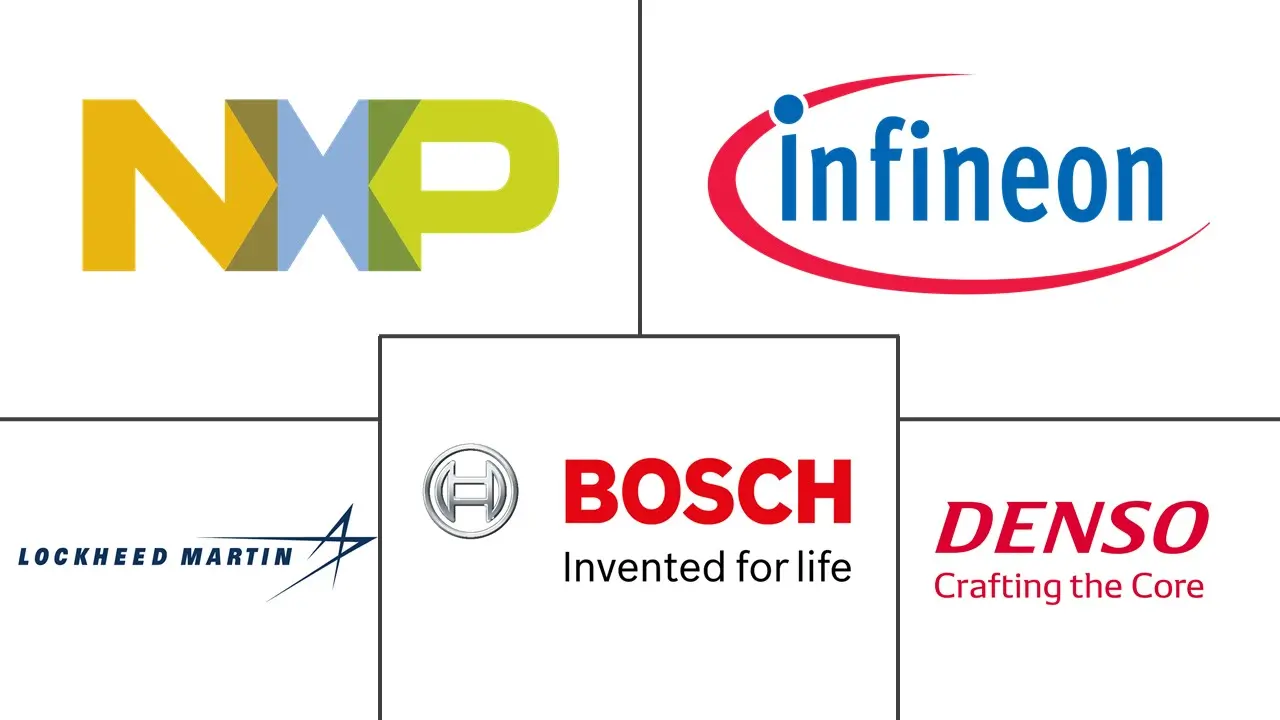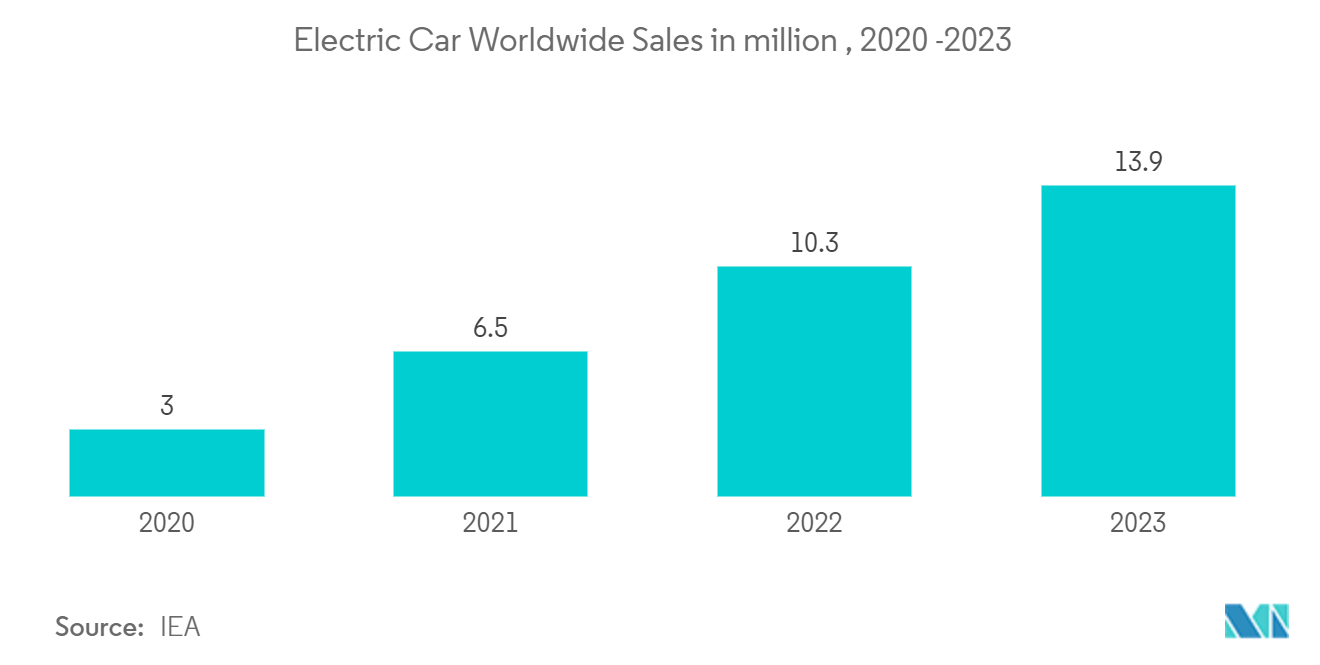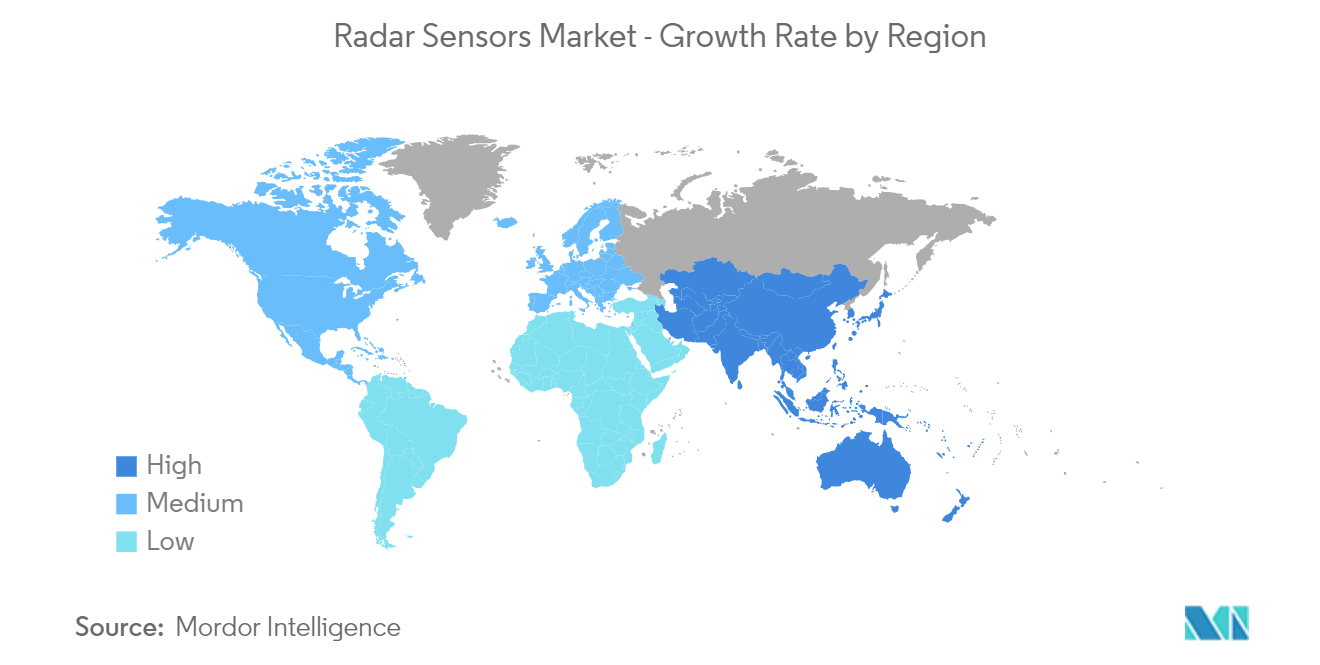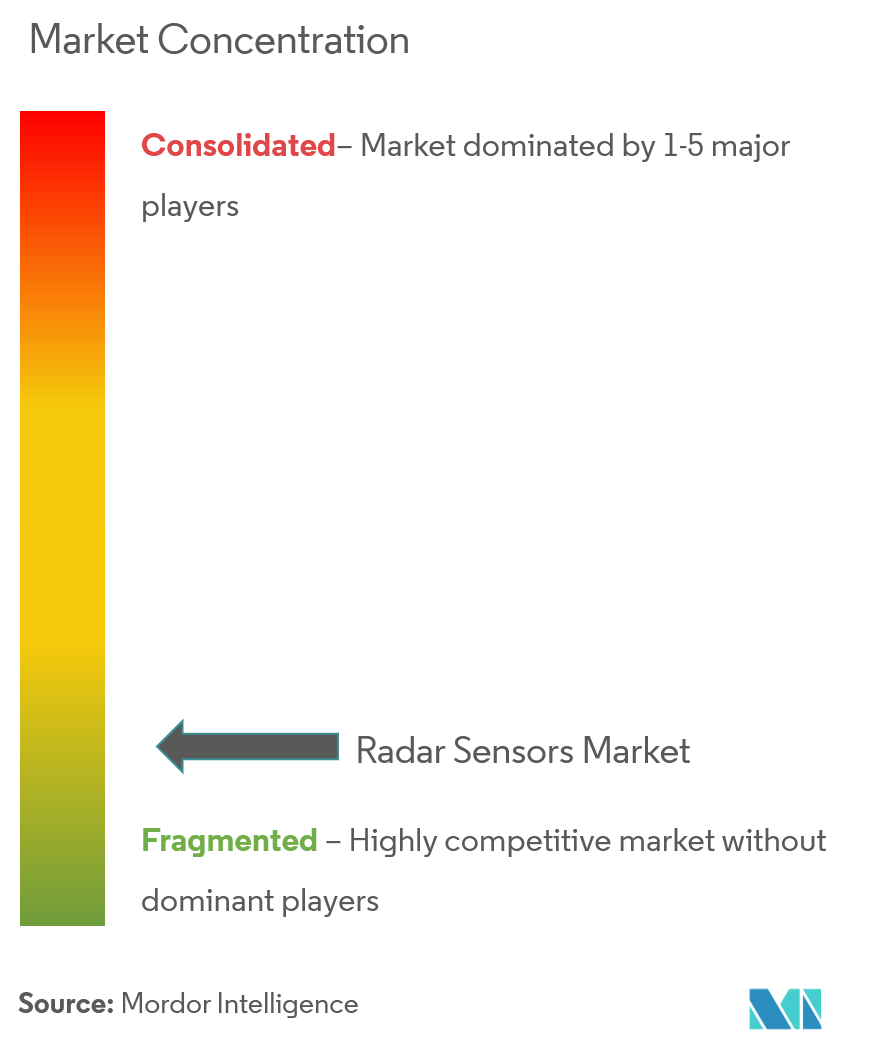Radar Sensors Market Size

| Study Period | 2019 - 2029 |
| Market Size (2024) | USD 21.03 Billion |
| Market Size (2029) | USD 45.42 Billion |
| CAGR (2024 - 2029) | 16.65 % |
| Fastest Growing Market | Asia Pacific |
| Largest Market | North America |
Major Players
*Disclaimer: Major Players sorted in no particular order |
Radar Sensors Market Analysis
The Radar Sensors Market size is estimated at USD 21.03 billion in 2024, and is expected to reach USD 45.42 billion by 2029, growing at a CAGR of 16.65% during the forecast period (2024-2029).
The Radar Sensors Market size is estimated at USD 21.03 billion in 2024, and is expected to reach USD 45.42 billion by 2029, growing at a CAGR of 16.65% during the forecast period (2024-2029).
The rapidly increasing automation, such as the developments toward autonomous driving and the progression of Industry 4.0, indicates the increasing demand for presence and motion detection for enhanced safety and control, driving the need for radar sensors.
Consumer demand for automobiles is responsible for the market's expansion. For instance, around 290.8 million registered cars in the US in 2022. Since last year, this proportion has climbed by 0.4%. As a result, the need for radar sensors is anticipated to increase. Additionally, automobiles often use radar sensors for features like rear cross-traffic alert (RCTA), lane change assistance, collision prevention, and blind spot detection (BSD).
Furthermore, due to low-cost, high-frequency components, innovative packaging concepts, and cutting-edge production processes, radar sensors are no longer bulky and expensive. These are cost-effective solutions for measuring jobs inaccessible to traditional optical or acoustic/ultrasound equipment.
The applications of radar sensors are becoming more diverse, and commercialization in the sector is accelerating owing to significant advancements in digital and RF/microwave technologies. There are various radar applications, from traditional defense and surveillance to automotive radar for driver assistance to biomedical radar for imaging, monitoring, and treatment. The competitive environment demands rapid design cycles, system integration, prototyping, and testing for all these applications.
Due to affordable high-frequency components, novel packaging solutions, and advanced production processes, radar sensors are no longer huge and expensive. They are low-cost solutions for measurement tasks that cannot be delivered with traditional optical or acoustic/ultrasound systems. The market for radar sensors is dominated by the automotive, industrial, and building automation solution segments, owing to the increasing demand for precision in detection.
Vendors in the market offer radar sensors based on range and technology (continuous and pulsating). Long-range radar applications are based on 77-GHz frequency. However, 79GHz also gains traction for short and mid-range applications, like industrial and automotive, owing to the higher form factor with 3X smaller antennas. It also has the benefit of a wide frequency band of 4GHz (77 to 81 GHz). Furthermore, the implementation of corner radar for 360-degree car surveillance, supported by short- and mid-range radars of 24 GHz, is gaining traction for high-resolution tracking. This enhances target separation or object recognition with high channel numbers for high-resolution imaging radar.
However, factors such as limited field of vision and limitations in the detection capabilities, when there is a speed difference between vehicles are some of the major factors challenging the growth of the studied market.
Radar Sensors Market Trends
Automotive Sector to Hold Significant Market Share During the Forecast Period
The robust growth of the autonomous car market has been instrumental in driving the radar sensor market. For instance, according to OICA, in 2022, about 81.63 million motor vehicles were sold worldwide. This was an increase of about 3.47% compared to the year 2020.
Blind spot detection (BSD), collision mitigation (CM), lane change assistance (LCA), parking assistance (PA), and rear cross-traffic alert (RCTA) functions are the most common uses of radar sensors in automobiles. The increase in AEB (automatic emergency braking) applications in the 77 GHz radar market is primarily responsible for expanding the market for automotive radar sensors.
The New Car Assessment Programme among OEMs, which integrates these systems to supplement camera devices for ADAS applications, is the driving force behind the development of radar technology. Radars offer improved safety and collision avoidance information when used with other sensors.
With the recent focus on safety in the United States, such as the release of new federal guidance for automated vehicles- Automated Vehicles 3.0 by the NHTSA, the market potential for ADAS has been extended to mid-end cars, resulting in a production volume increase. Many brands are increasingly employing radar sensors. The factors above are significantly impacting the market for radar sensors.
Furthermore, with the advent and demand for smart and self-driving cars, the market for radar sensors is expected to grow significantly, owing to the developments in the automotive sector. There are several vendors offering radar sensors for the automotive industry. For instance, Infineon provides a range of RASIC 77/79 GHz front-end radar sensor ICs as part of its comprehensive XENSIV family of sensors. These sensors are specifically designed for driver assistance systems, such as collision warning and adaptive cruise control.

North America to Hold Significant Share of the Radar Sensors Market
The North American radar sensor market is driven by high-end defense applications, smartphone penetration, autonomous cars, and consumer electronic devices. The increase in FMCW applications is gaining momentum in the region, especially short-range applications, as the region has the highest defense expenditure in the world.
The North American region is a pioneer in adopting new technologies, such as smart grids, smart homes, smart water networks, intelligent transport, and infrastructure with radar sensors technology. The advancement in rada sensor technology is expected to open new use cases across these industries, creating growth opportunities for the vendors.
The high penetration rate of smartphones is also expected to drive the demand for radar sensors as smartphone manufacturers increasingly include new sensors and features in their smartphones. According to GSMA, by the end of 2025, 5G will account for almost two-thirds of North America's mobile connections, equivalent to nearly 270 million contacts.
Considering the benefits associated with radar sensors, several public and private organizations are increasing their R&D efforts to further improve the efficiency of radar sensors, which is expected to positively impact the studied market. For instance, in June 2022, a leading automotive manufacturer in the United States registered a new high-resolution radar unit with the U.S. Federal Communications Commission (FCC).

Radar Sensors Industry Overview
The radar sensors market is fragmented due to the presence of many players. Some prominent players in the market include Robert Bosch Gmbh, Lockheed Martin Corporation, NXP Semiconductors, and Infineon Technologies, among others. The industry has undergone several developments over the past few years, significantly transforming the studied market. Some of the recent developments in the market include -
In July 2022, Gapwaves, a Swedish tech company, and Bosch, a leading global automotive supplier, announced their partnership for developing and large-scale production of high-resolution radar antennas for automotive vehicle applications. As part of the joint development, Gapwaves will support with its antenna know-how, and Bosch will contribute with its know-how of radar sensors and automated driving.
In May 2022, Infineon Technologies launched XENSIV 60 GHz automotive radar sensor (BGT60ATR24C). These sensors are designed for in-cabin monitoring systems (ICMS) to detect micro-movements and vital signs of left-behinds and sound the alarm. Additionally, the sensor chipset also addresses applications such as high-resolution frequency modulated continuous wave (FMCW) radars for distance measurement, front-end radar for gesture sensing, short-range sensing operations, and other hidden sensing applications.
Radar Sensors Market Leaders
-
Robert Bosch GmbH
-
Lockheed Martin Corporation
-
NXP Semiconductors NV
-
Infineon Technologies AG
-
Denso Corporation
*Disclaimer: Major Players sorted in no particular order

Radar Sensors Market News
- January 2024: NXP Semiconductors N.V. launched an extension to its automotive radar one-chip family. The new SAF86xx seamlessly integrates a high-performance radar transceiver, a multi-core radar processor, and a MACsec hardware engine to facilitate cutting-edge secure data communication via Automotive Ethernet. This comprehensive system solution lays the groundwork for advanced, software-defined radar technology when coupled with NXP's S32 high-performance processors, vehicle network connectivity, and power management capabilities.
- January 2024: TI introduced a range of all-in-one automotive solutions, including the first radar sensor explicitly designed for satellite architectures. They also launched new automotive devices capable of simplifying complex systems into single chips. TI's latest offerings could serve as a ready-made solution for designers aiming to enhance vehicle performance while meeting safety standards.
- December 2022: The Indy Autonomous Challenge (IAC) has received exclusive support from the technology company Continental. This large-scale collaborative project brings public-private partnerships and academic institutions together to design, build, and demonstrate a new generation of automated vehicle software to operate completely autonomous racecars. The business will provide the IAC access to its ARS540 4D imaging radar sensors for use in the Dallara AV-21, the fastest autonomous racecar in the world and a vehicle capable of highly automated driving.
- February 2022: NXP Semiconductor announced that innovative micro, one of its partners, had made an essential next step and developed a 4D imaging radar sensor with NXP's 6th generation flagship radar processor S32R45 that cascades four TEF8232 transceivers with a total of 192 virtual channels for delivering an angular resolution of one-degree at a distance up to 300 meters.
- January 2022: DENSO, a leading mobility supplier, announced that it had developed the Global Safety Package, an active safety system designed to improve the safety of vehicles by giving them high sensing capability of their surroundings. The safety package offers a combined performance of a vision sensor and a millimeter-wave radar sensor to assist the driver in controlling the vehicle safely.
Radar Sensors Market Report - Table of Contents
1. INTRODUCTION
- 1.1 Study Assumptions and Market Definition
- 1.2 Scope of the Study
2. RESEARCH METHODOLOGY
3. EXECUTIVE SUMMARY
4. MARKET INSIGHTS
- 4.1 Market Overview
- 4.2 Industry Value Chain Analysis
-
4.3 Industry Attractiveness - Porter's Five Forces Analysis
- 4.3.1 Bargaining Power of Suppliers
- 4.3.2 Bargaining Power of Buyers
- 4.3.3 Threat of New Entrants
- 4.3.4 Intensity of Substitute Product
- 4.3.5 Threat of Competitive Rivalry
- 4.4 Impact of COVID-19 on the Radar Sensor Market
5. MARKET DYNAMICS
-
5.1 Market Drivers
- 5.1.1 Increasing Need for National Security
- 5.1.2 Increasing Number of Autonomous Cars and Focus on Security and Safety Needs
-
5.2 Market Challenges
- 5.2.1 High R&D and Maintenance Costs
6. MARKET SEGMENTATION
-
6.1 By Type
- 6.1.1 Imaging Radar
- 6.1.2 Non-imaging Radar
-
6.2 By Range
- 6.2.1 Short-range Radar Sensor
- 6.2.2 Medium-range Radar Sensor
- 6.2.3 Long-range Radar Sensor
-
6.3 By End User
- 6.3.1 Automotive
- 6.3.2 Security and Surveillance
- 6.3.3 Industrial
- 6.3.4 Environment and Weather Monitoring
- 6.3.5 Traffic Monitoring
- 6.3.6 Other End Users
-
6.4 By Geography
- 6.4.1 North America
- 6.4.2 Europe
- 6.4.3 Asia-Pacific
- 6.4.4 Latin America
- 6.4.5 Middle East & Africa
7. COMPETITIVE LANDSCAPE
-
7.1 Company Profiles
- 7.1.1 Robert Bosch GmbH
- 7.1.2 Continental AG
- 7.1.3 Denso Corporation
- 7.1.4 Delphi Automotive LLP
- 7.1.5 Hella KGaA Hueck & Co.
- 7.1.6 Infineon Technologies AG
- 7.1.7 Baumer Group
- 7.1.8 Lockheed Martin Corporation
- 7.1.9 NXP Semiconductors NV
- 7.1.10 Smart Microwave Sensors GmbH
- 7.1.11 InnoSenT GmbH
- 7.1.12 Veoneer Inc.
- 7.1.13 STMicroelectronics NV
- 7.1.14 Hitachi Automotive Systems (Hitachi Ltd)
- 7.1.15 Banner Engineering Corporation
- *List Not Exhaustive
8. INVESTMENT ANALYSIS
9. FUTURE OF THE MARKET
** Subject To AvailablityRadar Sensors Industry Segmentation
A radar sensor is a device that monitors the distance, speed, and motions of objects across great distances while also calculating the relative speed of the item being seen. This sensor determines the object's form, location, motion trajectory, and motion characteristics using wireless detecting technologies like FMCW (Frequency Modulated Continuous Wave).
The Radar Sensors Market is Segmented by Type (Imaging and Non-imaging Radar), Range (Short-Range Radar Sensor, Medium Range Radar Sensor, and Long-range Radar Sensor), End User (Automotive, Security and Surveillance, Industrial, Environment and Weather Monitoring, Traffic Monitoring), and Geography. The report offers the market size in value terms in USD for all the abovementioned segments.
| By Type | Imaging Radar |
| Non-imaging Radar | |
| By Range | Short-range Radar Sensor |
| Medium-range Radar Sensor | |
| Long-range Radar Sensor | |
| By End User | Automotive |
| Security and Surveillance | |
| Industrial | |
| Environment and Weather Monitoring | |
| Traffic Monitoring | |
| Other End Users | |
| By Geography | North America |
| Europe | |
| Asia-Pacific | |
| Latin America | |
| Middle East & Africa |
Radar Sensors Market Research FAQs
How big is the Radar Sensors Market?
The Radar Sensors Market size is expected to reach USD 21.03 billion in 2024 and grow at a CAGR of 16.65% to reach USD 45.42 billion by 2029.
What is the current Radar Sensors Market size?
In 2024, the Radar Sensors Market size is expected to reach USD 21.03 billion.
Who are the key players in Radar Sensors Market?
Robert Bosch GmbH, Lockheed Martin Corporation, NXP Semiconductors NV, Infineon Technologies AG and Denso Corporation are the major companies operating in the Radar Sensors Market.
Which is the fastest growing region in Radar Sensors Market?
Asia Pacific is estimated to grow at the highest CAGR over the forecast period (2024-2029).
Which region has the biggest share in Radar Sensors Market?
In 2024, the North America accounts for the largest market share in Radar Sensors Market.
What years does this Radar Sensors Market cover, and what was the market size in 2023?
In 2023, the Radar Sensors Market size was estimated at USD 17.53 billion. The report covers the Radar Sensors Market historical market size for years: 2019, 2020, 2021, 2022 and 2023. The report also forecasts the Radar Sensors Market size for years: 2024, 2025, 2026, 2027, 2028 and 2029.
Radar Sensors Industry Report
Statistics for the 2024 Radar Sensors market share, size and revenue growth rate, created by Mordor Intelligence™ Industry Reports. Radar Sensors analysis includes a market forecast outlook to 2029 and historical overview. Get a sample of this industry analysis as a free report PDF download.



